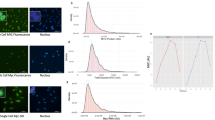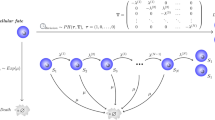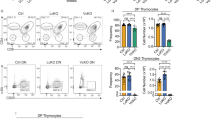Abstract
T lymphocytes and B lymphocytes integrate activating signals to control the size of their proliferative response. Here we report that such control was achieved by timed changes in the production rate of cell-cycle-regulating proto-oncoprotein Myc, with division cessation occurring when Myc levels fell below a critical threshold. The changing pattern of the level of Myc was not affected by cell division, which identified the regulating mechanism as a cell-intrinsic, heritable temporal controller. Overexpression of Myc in stimulated T cells and B cells did not sustain cell proliferation indefinitely, as a separate 'time-to-die' mechanism, also heritable, was programmed after lymphocyte activation and led to eventual cell loss. Together the two competing cell-intrinsic timed fates created the canonical T cell and B cell immune-response pattern of rapid growth followed by loss of most cells. Furthermore, small changes in these timed processes by regulatory signals, or by oncogenic transformation, acted in synergy to greatly enhance cell numbers over time.
This is a preview of subscription content, access via your institution
Access options
Subscribe to this journal
Receive 12 print issues and online access
$209.00 per year
only $17.42 per issue
Buy this article
- Purchase on Springer Link
- Instant access to full article PDF
Prices may be subject to local taxes which are calculated during checkout







Similar content being viewed by others
References
Marchingo, J.M. et al. T cell signaling. Antigen affinity, costimulation, and cytokine inputs sum linearly to amplify T cell expansion. Science 346, 1123–1127 (2014).
Mescher, M.F. et al. Signals required for programming effector and memory development by CD8+ T cells. Immunol. Rev. 211, 81–92 (2006).
Zehn, D., Lee, S.Y. & Bevan, M.J. Complete but curtailed T-cell response to very low-affinity antigen. Nature 458, 211–214 (2009).
Hawkins, E.D., Markham, J.F., McGuinness, L.P. & Hodgkin, P.D. A single-cell pedigree analysis of alternative stochastic lymphocyte fates. Proc. Natl. Acad. Sci. USA 106, 13457–13462 (2009).
Turner, M.L., Hawkins, E.D. & Hodgkin, P.D. Quantitative regulation of B cell division destiny by signal strength. J. Immunol. 181, 374–382 (2008).
Vervoorts, J., Lüscher-Firzlaff, J. & Lüscher, B. The ins and outs of MYC regulation by posttranslational mechanisms. J. Biol. Chem. 281, 34725–34729 (2006).
Laurenti, E. et al. Hematopoietic stem cell function and survival depend on c-Myc and N-Myc activity. Cell Stem Cell 3, 611–624 (2008).
Donnelly, R.P. & Finlay, D.K. Glucose, glycolysis and lymphocyte responses. Mol. Immunol. 68, 2 Pt C, 513–519 (2015).
Preston, G.C. et al. Single cell tuning of Myc expression by antigen receptor signal strength and interleukin-2 in T lymphocytes. EMBO J. 34, 2008–2024 (2015).
Wang, R. et al. The transcription factor Myc controls metabolic reprogramming upon T lymphocyte activation. Immunity 35, 871–882 (2011).
Liu, J. & Levens, D. Making myc. Curr. Top. Microbiol. Immunol. 302, 1–32 (2006).
Conacci-Sorrell, M., McFerrin, L. & Eisenman, R.N. An overview of MYC and its interactome. Cold Spring Harb. Perspect. Med. 4, a014357 (2014).
Dang, C.V. MYC on the path to cancer. Cell 149, 22–35 (2012).
Vita, M. & Henriksson, M. The Myc oncoprotein as a therapeutic target for human cancer. Semin. Cancer Biol. 16, 318–330 (2006).
Adams, J.M. et al. The c-myc oncogene driven by immunoglobulin enhancers induces lymphoid malignancy in transgenic mice. Nature 318, 533–538 (1985).
Ogilvy, S. et al. Constitutive Bcl-2 expression throughout the hematopoietic compartment affects multiple lineages and enhances progenitor cell survival. Proc. Natl. Acad. Sci. USA 96, 14943–14948 (1999).
Hawkins, E.D., Turner, M.L., Dowling, M.R., van Gend, C. & Hodgkin, P.D. A model of immune regulation as a consequence of randomized lymphocyte division and death times. Proc. Natl. Acad. Sci. USA 104, 5032–5037 (2007).
Gregory, M.A. & Hann, S.R. c-Myc proteolysis by the ubiquitin-proteasome pathway: stabilization of c-Myc in Burkitt's lymphoma cells. Mol. Cell. Biol. 20, 2423–2435 (2000).
Nie, Z. et al. c-Myc is a universal amplifier of expressed genes in lymphocytes and embryonic stem cells. Cell 151, 68–79 (2012).
Duffy, K.R. & Hodgkin, P.D. Intracellular competition for fates in the immune system. Trends Cell Biol. 22, 457–464 (2012).
Duffy, K.R. et al. Activation-induced B cell fates are selected by intracellular stochastic competition. Science 335, 338–341 (2012).
Hawkins, E.D. et al. Measuring lymphocyte proliferation, survival and differentiation using CFSE time-series data. Nat. Protoc. 2, 2057–2067 (2007).
Kinjyo, I. et al. Real-time tracking of cell cycle progression during CD8+ effector and memory T-cell differentiation. Nat. Commun. 6, 6301 (2015).
Marchingo, J.M. et al. T cell stimuli independently sum to regulate an inherited clonal division fate. Nat. Commun. (in the press).
Raff, M. The mystery of intracellular developmental programmes and timers. Biochem. Soc. Trans. 34, 663–670 (2006).
Burton, P.B.J., Raff, M.C., Kerr, P., Yacoub, M.H. & Barton, P.J.R. An intrinsic timer that controls cell-cycle withdrawal in cultured cardiac myocytes. Dev. Biol. 216, 659–670 (1999).
Link, J.M. & Hurlin, P.J. The activities of MYC, MNT and the MAX-interactome in lymphocyte proliferation and oncogenesis. Biochimica et Biophysica Acta. 1849, 554–562 (2015).
Prendergast, G.C. Mechanisms of apoptosis by c-Myc. Oncogene 18, 2967–2987 (1999).
Cory, S., Huang, D.C.S. & Adams, J.M. The Bcl-2 family: roles in cell survival and oncogenesis. Oncogene 22, 8590–8607 (2003).
Strasser, A., Harris, A.W., Bath, M.L. & Cory, S. Novel primitive lymphoid tumours induced in transgenic mice by cooperation between myc and bcl-2. Nature 348, 331–333 (1990).
Aukema, S.M. et al. Double-hit B-cell lymphomas. Blood 117, 2319–2331 (2011).
Hommel, M. & Hodgkin, P.D. TCR affinity promotes CD8+ T cell expansion by regulating survival. J. Immunol. 179, 2250–2260 (2007).
Bouillet, P. et al. Proapoptotic Bcl-2 relative Bim required for certain apoptotic responses, leukocyte homeostasis, and to preclude autoimmunity. Science 286, 1735–1738 (1999).
Smith, D.P., Bath, M.L., Metcalf, D., Harris, A.W. & Cory, S. MYC levels govern hematopoietic tumor type and latency in transgenic mice. Blood 108, 653–661 (2006).
Deenick, E.K., Gett, A.V. & Hodgkin, P.D. Stochastic model of T cell proliferation: a calculus revealing IL-2 regulation of precursor frequencies, cell cycle time, and survival. J. Immunol. 170, 4963–4972 (2003).
Liu, X. et al. Generation of mammalian cells stably expressing multiple genes at predetermined levels. Anal. Biochem. 280, 20–28 (2000).
Acknowledgements
We thank S. Cory (The Walter and Eliza Hall Institute) for vav-myc10 mice; P. Bouillet (The Walter and Eliza Hall Institute) for Bcl-2-Tg, Bcl2l11−/− and Eμ-Myc mice; M. Hancock and T. Kratina for technical assistance; J. Zhou for help in figure preparation; and S. Cory, M. Dowling, K. Duffy and A. Strasser for critical review of the manuscript. Supported by the National Health and Medical Research Council of Australia (Project Grants 1010654 and 1057831 and Program Grant 1054925; and fellowships to P.D.H. and L.M.C.), Victorian State Government Operational Infrastructure Support, an Australian Government NHMRC Independent Research Institutes Infrastructure Support Scheme (361646), The Australian Department of Education and Training (Australian Postgraduate Award to J.M.M.), The Walter and Eliza Hall Institute (Edith Moffat Scholarship to J.M.M.), the Cancer Council of Victoria (Sydney Parker Smith Postdoctoral Research Fellowship to J.M.M.) and The University of Melbourne (Melbourne International Research Scholarship for B.K.L. and Melbourne International Fee Remission Scholarship for B.K.L.).
Author information
Authors and Affiliations
Contributions
S.H. and P.D.H. oversaw all the work performed and wrote the manuscript, S.H., T.B.G., B.K.L. and L.M.C. performed the experiments; and S.H., T.B.G., A.K., J.M.M., L.M.C. and P.D.H. analyzed and interpreted the data.
Corresponding author
Ethics declarations
Competing interests
The authors declare no competing financial interests.
Integrated supplementary information
Supplementary Figure 1 Estimation of DD and time to reach DD.
The time for a cell population to stop dividing is estimated using a mean division number (MDN) versus time plot. MDN at any given time point is calculated using the precursor cohort model as described in1. When the cell population reaches DD the MDN plateaus. The mean DD of the population is defined as the maximum MDN reached by the population. The maximum mean division number is estimated by the highest point in the MDN over time curve as indicated by the solid blue line. The division rate is estimated from the slope of a line fitted (grey solid line) through at least 3 consecutive data points with increasing MDN values. Time to destiny (DD time) is estimated to be at the intersection of maximum MDN with the division rate as indicated by the green dashed line.
Supplementary Figure 2 Forced expression of Myc drives division progression in B cells and T cells.
Time course of CTV labelled B cells from (a) C57BL/6 or (b) Bcl-2-Tg mice stimulated with CpG for 24 h before infection with control (top panel) or Myc-expressing (bottom panel) GFP+ retroviruses as in (Fig. 2). c, d, Myc protein expression was measured by intracellular staining in B cells transduced with GFP+ retrovirus as in (a, b). Representative plots measured at (c) 65.5h or (d) 89.5h post activation with CpG. Only cells transduced with retrovirus expressing Myc (GFP+ population) show elevated and sustained Myc protein expression in both WT and Bcl-2-Tg cells. e, Total cell number, f, MDN and g, Myc protein levels measured by flow cytometry over time in CTV labelled CpG stimulated B cells from Eμ-Myc mice (black circles) or C57BL/6 (WT) mice (grey triangles). At 48h post activation cells were split into new culture wells and fresh media was provided. h, Representative dot plots of CTV labelled CD8+ T cells from vavP-Myc10 mice expressing congenic marker Ly5.2 co-cultured with CTV labelled CD8+ T cells from C57BL/6-Ly5.1 (expressing Ly5.1 congenic marker, WT) mice. Cells were stimulated with plate bound anti-CD3 alone (top panel) or in combination with anti-CD28 (bottom panel). Cells were stained with an anti-Ly5.2-FITC (shown) and Ly5.1-PE antibody to distinguish vavP-Myc10 T cells from WT T cells. (a-d, h) Representative of triplicate culture wells, except for anti-CD3 stimulation alone at 72 hours and 96.5hours in (h), where flow cytometry profiles from triplicates were overlaid due to low event numbers. (e-g) mean +/- SEM from triplicate culture wells.
Supplementary Figure 3 Time dependent regulation of Myc.
a-c, Repeat experiment of Fig 4. a, Myc protein and b, MDN over time of Bcl2l11−/− OT-I CD8+ T cells stimulated with N4 and CD28 antibody as indicated. Times to DD indicated by dashed lines were estimated in (b) as described in Supplementary Figure 1. c, Decay curves fitted to Myc levels during the loss phase. gMFI data from (b) were log transformed and straight lines with the same decay rate forced fitted to data points displayed in the graph. Red circles indicate intersection of estimated DD time with fitted lines for each condition. Red dashed line indicates a putative common Myc DD threshold. d, Addition of CHX (dotted lines) to OTI/ Bcl2l11−/− CD8+ T cells stimulated with N4 and 20 μg/mL CD28 antibody and followed for 6 hours revealed that half-life of Myc is independent of division (data shown in (d) are from experiment shown in Fig 4). (a-d) mean +/- SEM from triplicate culture wells.
Supplementary Figure 4 Use of T cells and B cells from Myc-EGFP OT-I mice reveals that DD is controlled by Myc levels before the first division.
a, b Induction of EGFP after 24h of stimulation compared to unstimulated cells (top panels) and correlation of EGFP with Myc protein levels as determined by intracellular staining and flow cytometry (bottom panels) at 24h post stimulation in (a) CD8+ T cells stimulated with N4 and 2μg/mL CD28 antibodies or (b) CpG stimulated B cells from Myc-EGFP OT-I mice. (c-f) Level of Myc before first division determines DD. Data shown are from experiment shown in Fig. 5. Cells were stimulated for 24 hours with N4 and 6.32μg/mL CD28 antibodies (T cells, as in Fig. 5a-c) or CpG (B cells, as in Fig. 5 d-f) before being sorted on high FSC and high, medium or low levels of EGFP as reporter for Myc and placed back into culture without further stimulation. c, d, Correlation of DD with EGFP levels expressed after sorting of T cells (c) or B cells (d) from Myc-EGFP OT-I mice. Correlation r2, 0.99 and 0.95 for T and B cells respectively. e, f, Percent of small cells as measured by FSC as described in1 as a surrogate marker for cells that have returned to quiescence in (e) T cells or (f) B cells. (a, b) Representative of triplicate culture wells (c, d) DD calculated as mean +/- SEM from triplicate culture wells plotted versus EGFP measured after sorting. (e, f) mean +/- SEM from triplicate culture wells.
Supplementary Figure 5 Alteration of division times by MPA has no effect on Myc levels, destiny or death timers.
a, b MPA inhibits cell expansion over time (a) by slowing division times (b) in CTV labelled OTI/ Bcl2l11−/− CD8+ T cells stimulated with N4 and IL-2. c, d MPA does not affect cell survival as measured by total cohort number over time (calculated by dividing the number of cells per division by 2^division number and representing the number of cells contributing to the cell population as indicator for cell death over time) (c) or Myc protein levels (d). (a-d) mean +/- SEM from triplicate culture wells.
Supplementary Figure 6 Sensitive regulation of cell numbers by changes in DD and time to die.
a, Shows the lognormal distributions used to generate Fig. 4c where medians for times to reach DD and times to die are altered by 20% as shown. The calculated outcome for cell numbers with either change alone or together are plotted in Fig. 7g. Note, here the probability of dying is plotted as a negative pdf after Hawkins et al.22. Additional parameters of model are given in Supplementary Note 1. b, The fold differences in calculated cell numbers for each alteration over time are shown.
Supplementary information
Supplementary Text and Figures
Supplementary Figures 1–6, Supplementary Table 1, and Supplementary Note (PDF 750 kb)
Rights and permissions
About this article
Cite this article
Heinzel, S., Binh Giang, T., Kan, A. et al. A Myc-dependent division timer complements a cell-death timer to regulate T cell and B cell responses. Nat Immunol 18, 96–103 (2017). https://doi.org/10.1038/ni.3598
Received:
Accepted:
Published:
Issue Date:
DOI: https://doi.org/10.1038/ni.3598
This article is cited by
-
Molecular basis for potent B cell responses to antigen displayed on particles of viral size
Nature Immunology (2023)
-
Picking up speed: cell cycle regulation during effector CD8+ T cell differentiation
Medical Microbiology and Immunology (2023)
-
tRNA methylation — a new level of control for T cell immunity
Nature Immunology (2022)
-
The fellowship of regulatory and tissue-resident memory cells
Mucosal Immunology (2022)
-
MYC inhibition reprograms tumor immune microenvironment by recruiting T lymphocytes and activating the CD40/CD40L system in osteosarcoma
Cell Death Discovery (2022)



